Jarvis II (DD-393)
1937–1942
The second U.S. Navy ship named for James Canon Jarvis (1787–1800), the son of James Jarvis of New York, who was appointed a midshipman from that state on 23 March 1799. On 30 January 1800, 13-year-old Jarvis sailed on board frigate Constellation, Commodore Thomas Truxtun in command, when she set out from St. Kitts to seek battle against the French during the Quasi-War. Constellation sighted 52-gun French frigate La Vengeance, Capt. François M. Pitot in command, not far from Guadeloupe in the West Indies on 1 February 1800. The two ships adroitly maneuvered to gain the wind and closed, and Truxtun called on the French to heave to and strike their colors, to which the French defiantly answered by opening fire. The ships repeatedly fired into each other, and closed to board twice but both times broke away, and men in the tops shot down their foes’ crewmen, drenching the decks in blood.
During the ferocious battle the French blasted Constellation’s masts and sails, and Jarvis climbed aloft and commanded the topmen to secure the mainmast. An older seaman warned Jarvis that the mast might topple but he refused to come down. “My post is here,” he courageously replied, “I can’t leave it until ordered.” The enemy fire then carried away part of the mast, and Jarvis was swept over the side with the falling rigging. The Americans severely damaged La Vengeance, but she utilized the cover of darkness to escape from Constellation which, disabled by the loss of her mainmast, proved unable to pursue, and the battered French ship made Curaçao. “I regret much his loss,” Truxtun commended Jarvis’ duty in a report to Secretary of the Navy Benjamin Stoddert, “as a promising young officer and amiable young man.” The Sixth Congress deemed his sacrifice worthy of further honor and passed a joint resolution on 29 March 1800. “And be it further resolved: That the conduct of James Jarvis, a Midshipman in said frigate, who gloriously preferred certain death to an abandonment of his post, is deserving of the highest praise, and the loss of so promising an officer is a subject of National regret.”
II
(DD-393: displacement 1,850; length 341'4"; beam 35'6"; draft 10'4"; speed 35 knots; complement 158; armament 4 5-inch, 4 .50 cal. machine guns, 16 21-inch torpedo tubes, 2 depth charge tracks; class Gridley)
The second Jarvis (DD-393) was laid down on 21 August 1935 at Bremerton, Wash., by the Puget Sound Navy Yard; launched on 6 May 1937; sponsored by Mrs. Antoinette M. Craven, wife of Vice Adm. Thomas T. Craven, Commandant Thirteenth Naval District and Puget Sound Navy Yard; and commissioned on 27 October 1937, Lt. Cmdr. Robert R. Ferguson in command.
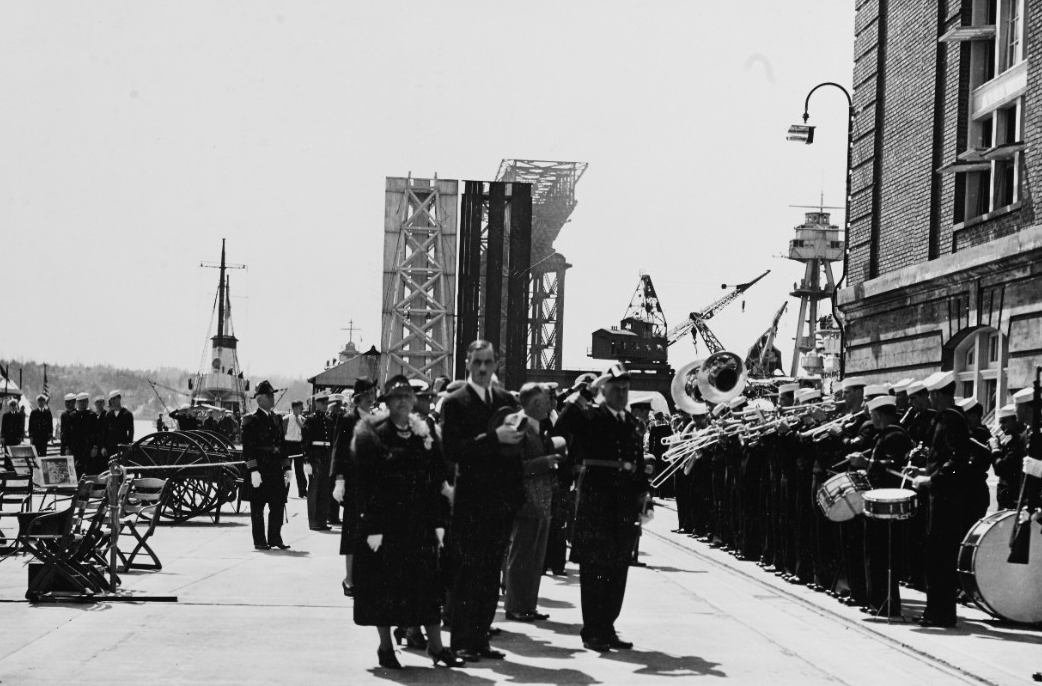
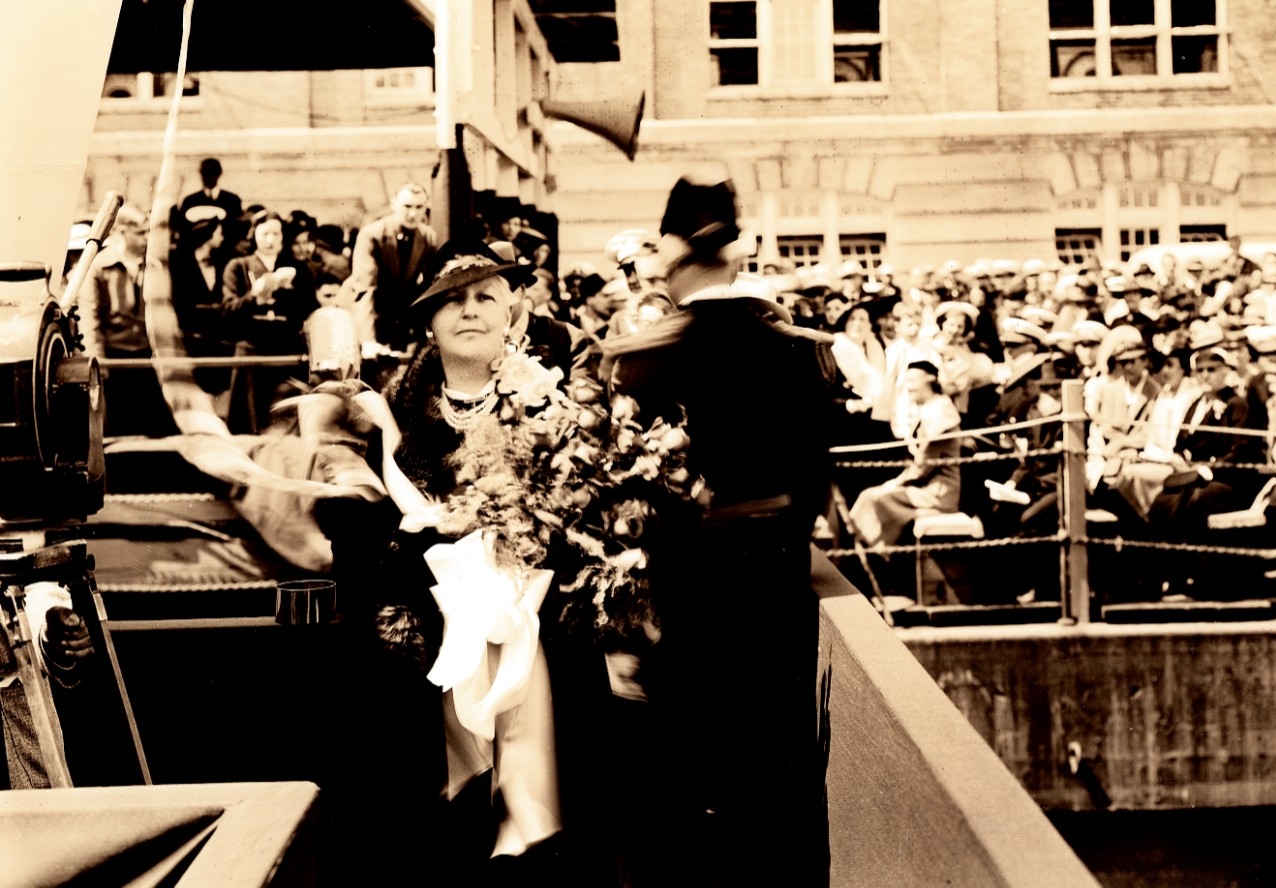
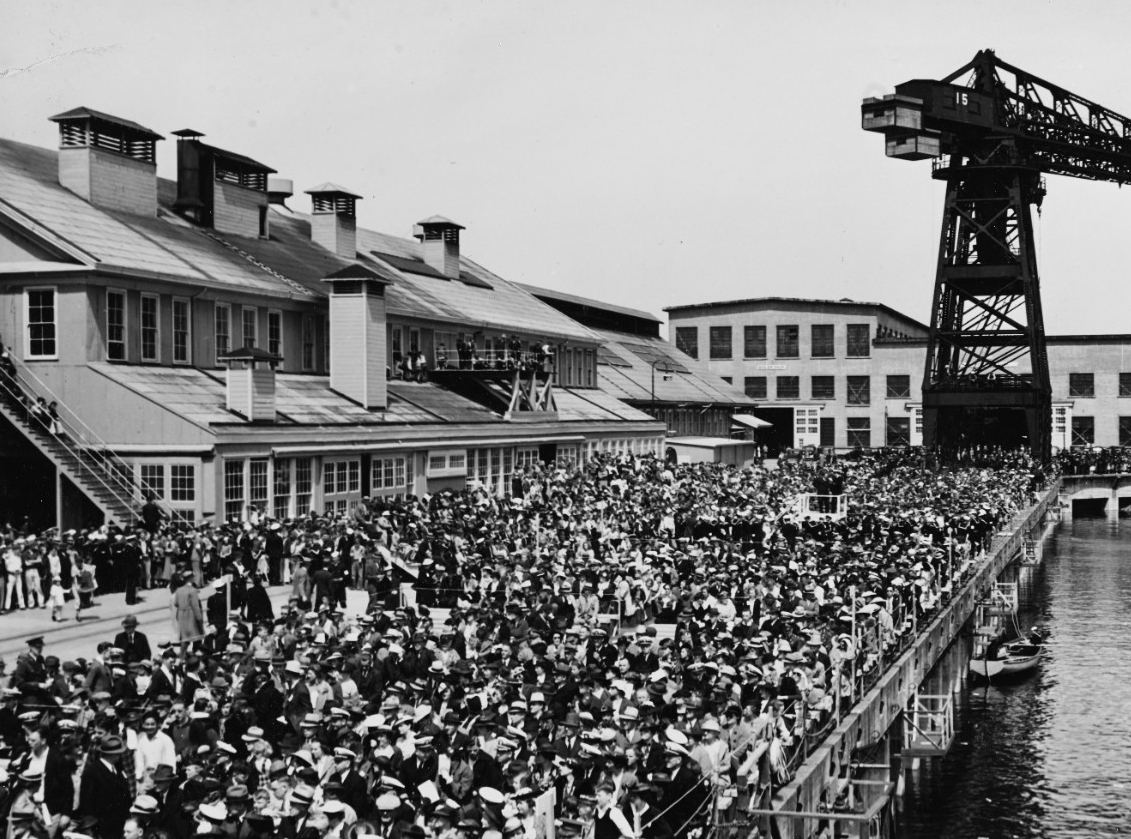
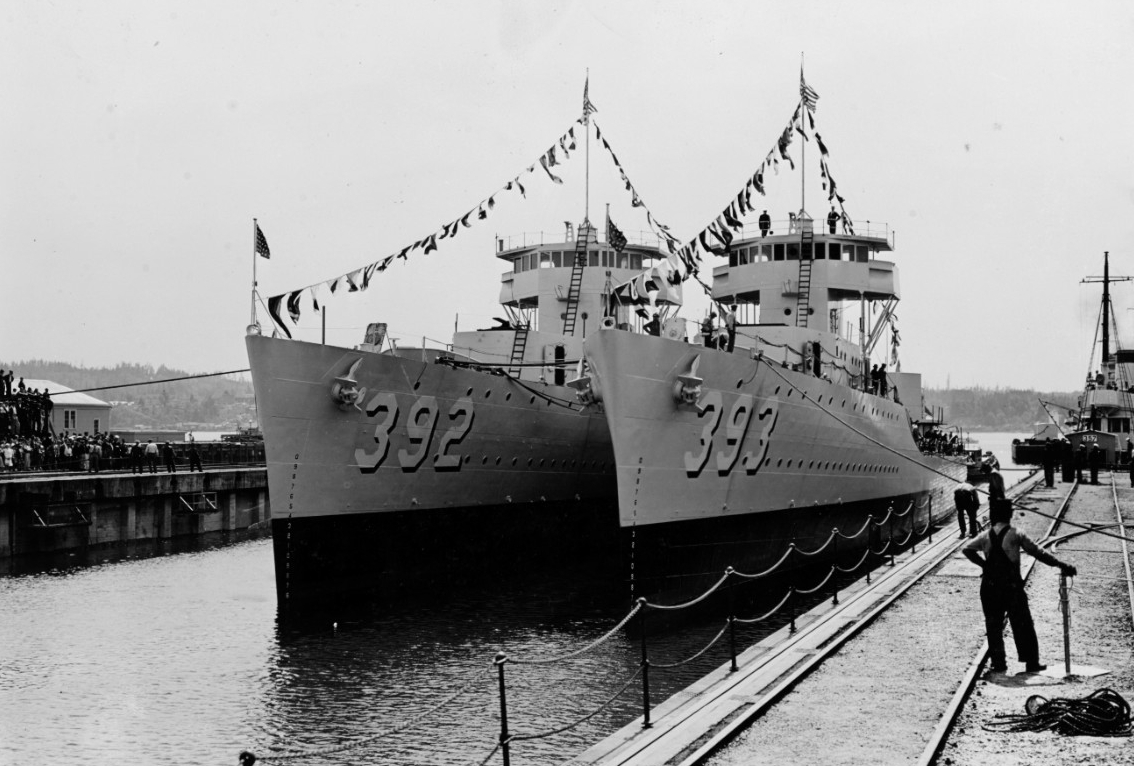
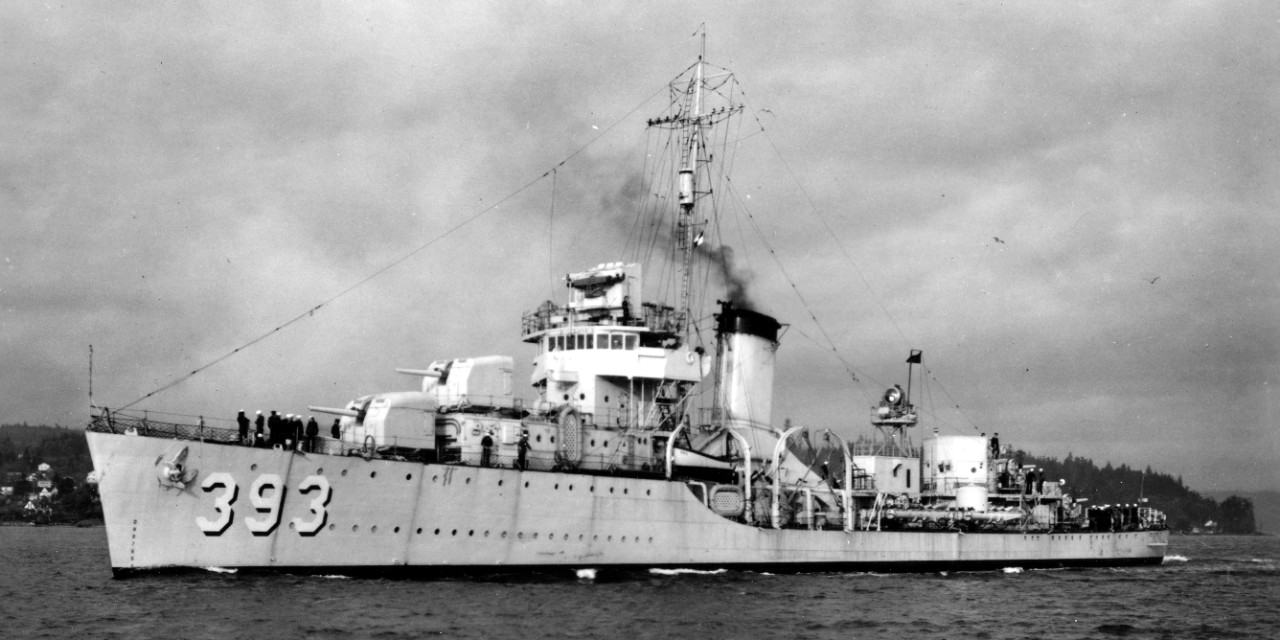
Jarvis cleared Puget Sound on 4 January 1938, and carried out her shakedown training out of San Diego, Calif., a voyage that took her southward to Magdalena Bay, Mexico. The ship then (12 February–6 May) returned to Puget Sound and completed alterations, following which, Jarvis operated along the California coast with Destroyer Squadron (DesRon) 6. The squadron eventually comprised two Destroyer Divisions (DesDivs) as the ships were commissioned and entered service: DesDiv 11 consisted of Craven (DD-382), Helm (DD-388), Henley (DD-391), and Jarvis, which served as the squadron’s relief flagship; and DesDiv 12, which comprised Benham (DD-397), Maury (DD-401), McCall (DD-400), and Somers (DD-381), the squadron flagship.
Destroyers could roll unmercifully in heavy seas and Jarvis was no exception. Junior officer Paul H. Backus struggled with seasickness during his midshipman’s cruise at the Naval Academy, and the scourge returned to plague him while he served as Jarvis’ communication and torpedo officer. Ens. Backus clung tenaciously to safety rails and bulkheads while the ship steamed at sea but normally stood his watches with a bucket beside him, just in case. Some of his shipmates ribbed him by painting an ‘E’ (Battle Efficiency) with two hashmarks (two subsequent awards) on his bunk, but the young officer evidently missed their humorous intention and recalled the incident fondly as a reward for his resolve.

Jarvis sometimes shifted temporarily between coasts for exercises, such as the annual fleet problems, which concentrated the Navy’s power to conduct maneuvers on the largest scale and under the most realistic conditions attainable. The ship thus took part in a series of exercises in the New Year (4 January–12 April 1939). She served as a plane guard for aircraft carriers Lexington (CV-2) and Ranger (CV-4) and conducted simulated torpedo attacks while steaming by way of the Panama Canal to the Caribbean. During one such exercise, Backus lined up a firing solution against heavy cruiser San Francisco (CA-38) using the after mounts on either side, a half salvo of eight torpedoes, but he miscalculated and forgot to adjust for “the vacant space in the middle where the other eight would be running.” San Francisco deftly turned inside and the first four torpedoes churned past to her port side and the other four to starboard, all of which missed the warship. Backus recalled the embarrassing episode with relief when they recovered all of the expensive torpedoes, an issue of concern in the cost-conscious pre-war Navy as the service emerged from the Great Depression.
Jarvis operated primarily from Guantánamo Bay, Cuba, while she participated in Fleet Problem XX, which ranged across the Caribbean and the northeast coast of South America (20–27 February). President Franklin D. Roosevelt observed the problem initially from on board Houston (CA-30), transferred to battleship Pennsylvania (BB-38), and then returned to Houston to watch the final exercises, and the chief executive’s presence led to the maneuvers becoming unusually publicized.
The opponents divided into two fleets, Black and White. Vice Adm. Andrews, Commander Scouting Force, U.S. Fleet, led the Black Fleet, which comprised six battleships, Ranger, eight heavy cruisers, six light cruisers, 32 destroyers, 15 auxiliaries, and five aircraft tenders. Vice Adm. Edward C. Kalbfus, Commander Battle Force, U.S. Fleet, took the White Fleet to sea, which also counted six battleships, as well as Enterprise (CV-6), Lexington, and Yorktown (CV-5) -- Vice Adm. Ernest J. King led the carriers -- six heavy cruisers, a half dozen light cruisers, 29 destroyers, 12 submarines, and target ship Utah (AG-16) as a surrogate for a trio of large troop ships. The opponents roughly balanced each other in numbers and types of ships, but the White Fleet counted more submarines and the fleets deployed different air strength. The Black Fleet contained only 72 carrier planes but nearly 60 floatplanes embarked on board the battleships and cruisers, 102 patrol planes supported by the tenders in (apparently) safe harbors, and 62 marine planes flying from ashore, and thus deployed stronger reconnaissance and scouting strength. The White Fleet deployed about 220 carrier aircraft and approximately 48 floatplanes on board the battleships and cruisers, and was thus stronger in carrier strength. A “Second Fleet” theoretically supported the White Fleet from an advanced base south of the Azores Islands.
The problem included: employing planes and carriers in connection with escorting a convoy; developing coordinating antisubmarine measures between aircraft and destroyers; and experimenting with various evasive tactics against attacking planes and submarines. Both of the admirals focused on their foe’s air power but in different ways — Andrews attempted to destroy the White Fleet, and Kalbfus used the convoy he was to protect as bait to lure the White Fleet into battle. The exercises wrapped-up as men of the 1st Battalion, 5th Marines made an opposed landing in Puerto Rico to gain an advanced base for the White Fleet. Controversy arose over the efficacy of patrol plane attacks on carriers and other ships, and that the principal that patrol aircraft were to operate as scouts required emphasis. In addition, evaluators recommended the necessity of fast battleships to supplement cruisers in carrier task forces. Jarvis visited Jacksonville, Fla., before she came about, passed through the Panama Canal on 28 April, and then resumed her schedule of tactics and training in Californian waters into the following year.
The destroyer then (1–10 April 1940) set out from San Diego for fleet exercises off the Hawaiian Islands, and entered Pearl Harbor, T.H., on 26 April. Operating from Pearl, Jarvis cruised the Pacific to Midway and Johnston Islands, and on 8 February 1941, set out for an overhaul at San Francisco, Calif., which she began on the 24th of that month. Returning to Pearl Harbor on 17 April to commence more than seven months of intensive maneuvers and battle practice, she put into Pearl Harbor on 4 December following exercises off Maui Island. The staff of DesRon 4, consisting of Capt. Cornelius W. Flynn, the commander, Lt. Cmdr. Earl K. Van Swearingen, Lt. Cmdr. John M. Wright, USNR, and Lt. Gustave N. Johansen, normally embarked on board Selfridge (DD-357), but that ship had just accomplished a special escort mission to Palmyra Island and only returned to Pearl Harbor on 6 December. Flynn therefore temporarily broke his flag in Jarvis, and with his staff expected to rejoin Selfridge on the 8th.
The Japanese Dai-ichi Kidō Butai (the 1st Mobile Striking Force), Vice Adm. Nagumo Chūichi in command, attacked Oahu on 7 December 1941. The morning dawned fair but cloudy with little wind, and Ens. William F. Greene, Jarvis’ communication and torpedo officer, recalled that “in general all was orderly and entirely normal about the harbor and ship.” Jarvis lay moored outboard port side to Mugford (DD-389) at berth 6 at Pearl Harbor Navy Yard, ahead of submarine tender Argonne (AS-10), minesweeper Tern (AM-31), and gunboat Sacramento (PG-19). Jarvis lay in a restricted availability status, and received light and water from the navy yard and steam from Mugford. Civilian workers and crewmen had opened two boilers on their water sides for cleaning, her port main reduction gear was out of commission because of renewal of gauges, thermometers, and lubricating oil fittings to permit cleaning of evaporators, and certain valves were out in all systems except for the main steam lines. Some of the work including welding on bulkheads adjacent to fuel tanks, and the fuel in those tanks had been pumped out to prevent a fire hazard. Lt. Cmdr. James R. Topper, the commanding officer, and a number of other officers including Van Swearingen and Wright, were ashore when the enemy struck, and Flynn was convalescing from an illness at the Naval Hospital at Pearl Harbor.
Ens. Greene served as the officer-of-the-deck and had made his rounds and just returned to the wardroom when, at 0758, he all but simultaneously heard a dull explosion and five boat-gongs, which summoned him to the quarterdeck. As Greene ran aft, he observed “a low-winged monoplane, silver, with a large red stripe or spot on fuselage, flying southward over Ford Island at not more than 3 or 400 feet, releasing a bomb.” The young ensign shouted for the watchstanders on the quarterdeck to sound general quarters. As the first wave of enemy bombers raked Battleship Row along Ford Island with torpedoes and bombs, Ens. Joseph A. Chiles, USNR, called Lt. Joel C. Ford Jr., and chillingly told him: “Someone is bombing us.” Lt. Johansen had been up late the night before and slept in until an ensign ran past his door and shouted excitedly: “We’re being attacked by Japanese aircraft!” Johansen greeted the news incredulously but donned his uniform and went to the bridge. Greene laconically appraised the situation in Jarvis’ deck log: “0758 Hostilities with Japan commenced with air raid on Pearl Harbor. Went to General Quarters.” SM1c Louis E. Simonin, who had only joined the ship in late November, sounded the alarm and the crew manned their battle stations.
Greene directed men around the quarterdeck and then entered the bridge, asked Ford, the senior officer present, for orders, and the latter sent him aft to get the after battery firing. Chiles organized the forward battery on his initiative, and Ens. Ralph V. Fleege, USNR, manned the director and Ford ordered Fleege to open fire on any enemy planes within range as soon as possible. He relayed that order to the destroyer’s guns and machine guns, put the forward 5-inch battery in automatic with director control, and the after battery in local control. Jarvis’ No. 1, 4 and 2 machine guns in rapid succession opened fire at a Japanese Nakajima B5N2 Type 97 carrier attack plane at 0804, and a few seconds later some of the gunners shifted fire to more Type 97s carrying torpedoes as the enemy attack planes flew their approaches from eastward over Merry Point at an altitude that Greene estimated at barely 50 feet. Johansen reached the bridge and saw “several” Type 97s pass astern of Jarvis, “flying low and slow” as they dropped torpedoes at the battlewagons moored along Battleship Row, watching in horror as “plumes of water” rose alongside Oklahoma (BB-37) when torpedoes ripped into her.
About a minute later the ship’s ‘33’ 5-inch gun mount began shooting. The gunners operated their guns in automatic for the most part, except when they swung on diving planes not already covered by Fleege and the director or when the director engaged planes from ahead. Despite the steady attacks and deafness caused by adjoining gun blast at low flying planes, all hands remained alert for servicing the guns, picking up targets, and for signaled orders of their gun captains and officers. Men fired machine guns at planes beyond range but Ford observed that although they wasted “considerable” ammunition the officers did not check their fire because of “its effect on morale.” Johansen afterward surmised that because most of the enemy planes flew low during the first wave, the ship’s 5-inch guns could not depress low enough to hit them, and at any rate, the fuses in the shells would not activate “that close to the ship.” The young lieutenant believed that a .50 cal. machine gun hit an enemy plane and caused a small fire in the root of the left wing, but the attacker did not fall. About halfway through the battle, a stoppage in hoist No. 3 occurred and men passed up powder and projectiles by hand. Upon notification, central sent excess men on the bridge and in radio to assist in passing the ammunition. During the occasional lulls, sailors filled ready boxes.
After the first attack, Greene ordered fire hoses run out on deck as a sensible precaution, but the enemy concentrated on other targets. Ford observed that Mugford also delivered “a high volume of fire” against the Japanese aircraft. The men in the fireroom laboriously began to light off the boilers and those in the engine room put valves in lines and warmed up the engines. MM2c A.M. Llewelyn realized that the tanks were low and evaporators apart, and on his own initiative began taking on water for the ship. Flynn, Topper, and most of the other officers ashore returned to Jarvis by whatever means they could find, while Van Swearingen and Wright returned to other ships and then transferred to Jarvis at sea. A machine gun bullet’s fragment pierced SN1c Leland H. Landrip in the thigh while he stood on the main deck passing ammunition to the guns aft, but he resolutely bound up the wound and continued passing rounds. A few men suffered minor burns and ear shock because they opened fire without taking time to insert cotton in their ears. Jarvis emerged from the attack with only superficial damage, however, and the shock of the gunfire broke the lens on No. 1 24-inch searchlight, while a fragment hit and imbedded itself in a remote control box of the 36-inch light, but did not damage the mechanism.
“From my personal investigation after coming on board,” Topper afterward proudly reported, “I found all action taken was timely and correct. Plans were being expeditiously carried out to get ship underway. Firing had ceased but all guns were manned ready for action. Morale was at highest pitch. Action taken appeared to be well thought out and deliberate. The actions of all on board were commendable.”
“The behavior of the crew and the junior officers was a source of great pride to me,” Ford also reported. “Organization of makeshift crews and the pursuance of the action were swift and efficient. There was no confusion. The entire performance was carried out as though it were an accustomed routine. My orders were few and general. Detail of execution were left to initiative of officers and petty officers at stations and results were gratifying… It is believed that the entire crew deserves considerable credit for the performance. All hands were on the guns except those engineers engaged in getting the ship ready to stream.”
Nagumo brought his carriers about following the raid and sailed from Hawaiian waters, but many Americans feared that the Japanese carriers might still be operating nearby. Consequently, Jarvis sortied that morning and worked with cruisers and destroyers that patrolled the area searching for Japanese submarines and aircraft. Task Force (TF) 8, Vice Adm. William F. Halsey Jr., in command and formed around Enterprise, had meanwhile delivered 12 Grumman F4F-3 Wildcats of Marine Fighting Squadron (VMF) 211 to Wake Island, but heavy seas (5–6 December), delayed her return from the afternoon of 6 December to the following morning, and thus ensured that the ship eluded the Japanese attack on Oahu. Enterprise joined in the searches for the Japanese but ran low on fuel and entered Pearl Harbor as the sun set on 8 December. The carrier refueled and provisioned amidst the carnage from the surprise attack, and returned to sea during the morning watch on the 9th. Jarvis briefly rendezvoused with the carrier and screened her while she searched for the enemy, and the destroyer then returned to Pearl Harbor to refuel and provision.
The marines on Wake repulsed a Japanese landing on 11 December 1941, and Jarvis joined TF 14, Rear Adm. Frank J. Fletcher in command and including Saratoga (CV-3), as Fletcher set out from Pearl Harbor on the 16th to relieve the garrison on Wake. The embarked reinforcements included 18 Brewster F2A 2 and 3 Buffaloes of VMF-221 on board Saratoga, and additional marines on board seaplane tender Tangier (AV-8). At times Enterprise and the cruisers launched planes in daily searches while patrolling with TF 11, Vice Adm. Wilson Brown Jr. (14–27 December 1941). Brown intended to launch a diversionary raid on Jaluit Island, but revised intelligence persuaded Brown to first attack Makin Island in the Gilbert Islands [Kiribati], and then diverted back to Wake to support the relief expedition. Saratoga and Tangier encountered delays owing to the slower speed of oiler Neches (AO-5) and from Fletcher’s decision to refuel the destroyers, however, and the Japanese consequently overran Wake. The relief expedition came about and returned to Pearl Harbor. Recalled to Pearl Harbor on the 23rd, Jarvis resumed her antisubmarine patrols on 29 December 1941.
On the afternoon of 22 January 1942, Vice Adm. Brown’s TF 11, formed around Lexington (CV-2), set out from Pearl Harbor to raid Wake Island, which the Japanese had overrun two days before Christmas. The task force was to rendezvous with Neches, refuel from the fleet oiler on 27 January, and then Lexington would launch planes to bomb the enemy garrison, and, if the situation permitted, some of the escorting cruisers would close and shell the island. Low clouds covered most of the sky and together with the darkness reduced visibility at 0310 on 23 January, when a violent thud shook Neches amidships, most likely a dud torpedo fired by Japanese submarine I-72, Cmdr. Togami Ichiro in command. I-72 continued to stalk the task force and fired a second torpedo that struck the oiler on the starboard side abaft the engine room nine minutes later. The explosion caused extensive flooding, shutting down the main engines and warping frames and watertight doors. Togami fired a third torpedo and surfaced to finish off Neches with gunfire, and her lookouts sighted the submarine about 2,000 yards to port at 0328, mere seconds before the third torpedo struck the port side forward, wrecking watertight integrity and dooming the oiler. The ship’s guns took the submarine under slow, deliberate fire for a few minutes until the list to starboard prevented the gunners from depressing their mounts sufficiently. Neches slowly settled forward and the list to starboard increased steadily. The crew calmly abandoned ship when the decks were awash and watched as Neches slowly sank, taking 56 men with her to the bottom about 135 miles west of Honolulu, near 21°01'N, 160°06'W. Grouped in four lifeboats, the survivors floated hoping for rescue, and Jarvis reached the appointed rendezvous about two hours before sunrise, only to discover empty sea. The destroyer attempted several times to hail the oiler on the radio without a response, but overheard a transmission from a patrol plane that claimed to spot the lifeboats. Jarvis turned to that course, increased to flank speed and reached the four lifeboats a couple of hours before noon and rescued 182 men. The loss of the oiler led to the cancellation of the projected raid on Wake, and Jarvis landed the survivors at Pearl Harbor that afternoon.
Army transport General Royal T. Frank moored at Honolulu on the morning of 27 January 1942, and embarked 26 soldiers who had just completed their basic training at nearby Schofield Barracks. The transport briefly visited Kaunakakai and then Kahului, both at Maui, T.H., and at 2100 sailed in company with high-speed minesweeper Trever (DMS-16) and freighter Kalae, which set out with a barge in tow, for Hilo, Hawaii. Japanese submarine I-171, Lt. Cmdr. Kawasaki Rokuro in command, sighted the small convoy and at dawn on the 28th fired two torpedoes at the transport, both of which missed. Kawasaki persevered and maneuvered into another firing position and shot a third torpedo, which sank General Royal T. Frank at about 0710, an estimated 30 miles north of Hawaii’s Upolu Point in the Alenuihāhā Channel. Kalae rescued 36 of the 60 souls on board, the Americans sent a distress message, and Trever depth charged I-171 but the submarine went deep and the high-speed minesweeper held to an easterly course while searching for her prey. Ships made for the scene and at 1300 Jarvis rendezvoused with Trevor, and shortly thereafter Jarvis, Trevor, Elliot (DMS-4), and Long (DMS-12) formed a scouting line at 300 yard intervals. Long reported a sonar contact on her port bow at 1400 and passed on the information to Jarvis, which picked up the contact and sent six depth charges exploding into the sea. Long followed with another deadly barrage of depth charges over the point but they lost the sound contact as a 30-foot-wide air bubble burst to the surface. Jarvis and Long regained sound contact at 1815 and 16 minutes later Jarvis churned the sea with another pattern of explosives, followed by Long. Two underwater detonations released an oil slick that the Americans believed marked the submarine’s grave, and the ships came about and resumed their patrols. The Japanese boat escaped, however, until Guest (DD-472) and Hudson (DD-475) depth charged and sank I-171 with all hands 15 miles west of Buka Island, near 05°37'S, 154°14'E, on 1 February 1944.
The Allies in the meantime reinforced the strategic chain of island bastions across the south Pacific, and these vulnerable convoys of soldiers and marines required protection. Jarvis therefore put to sea from Pearl Harbor on 9 February 1942, and helped escort a convoy of 11 troop transports, which reached Brisbane, Australia, on the 26th. Convoy BT.200 consisted of troopships Argentina, Cristobal, Island Mail, John Erickson (ex-Kungsholm), J.W. McAndrew (ex-Deltargentino), Santa Elena, Santa Rosa, and Thomas H. Barry (ex-Oriente), which carried 16,766 troops and 113 nurses of Poppy Force, the Army’s TF 6814, from the New York Port of Embarkation on 23 January 1942. Several of the ships had been converted from liners by the simple process of removing nearly all of their appurtenances and installing pipe bunks, and crewmen accomplished additional conversion during the voyage. The convoy passed through the Panama Canal (31 January–1 February), and on 27 February reached Melbourne, Australia, where the troops and their equipment were disembarked and spent a week recuperating from the voyage, as well as reorganizing the cargoes that had been hastily if not efficiently loaded. The ships resumed their journey as convoy ZK.7 from Melbourne to Nouméa (6–12 March). John Erickson experienced engine trouble and fell behind but reached safe harbor at Nouméa on 18 March. The soldiers formed the advance elements of what activated on 27 May as the Americal Division, a contraction of American, New Caledonian Division, and was subsequently designated the 23rd Infantry Division but usually known by the popular name. Maj. Gen. Alexander M. Patch, USA, initially led the division, which saw hard fighting during the Guadalcanal Campaign. Jarvis stood out of Brisbane on 7 March and joined Honolulu (CL-48), and together they screened some of the transports as they unloaded soldiers at Nouméa, until New Zealand light cruisers Achilles (70) and Leander (75) relieved them. Honolulu and Jarvis then turned their prows for home, touched at Pago Pago at American Samoa on 15 March, and on the 27th returned to Pearl Harbor. Jarvis then (8–15 April) took part in escorting a convoy to the San Francisco Oakland Bay area, where she underwent repairs and alterations at Mare Island Navy Yard. She returned to Pearl Harbor escorting 13 ships (9–18 May), and proceeded three days later in company with a convoy of heavily-laden ships to Suva at the Fiji Islands. She patrolled off that port while the ships unloaded, cleared Suva on 12 June, and then off New Caledonia joined a convoy bound for Sydney, Australia.
Jarvis reached Sydney on 18 June and joined TF 44, British Rear Adm. Victor A.C. Crutchley, RN, in command, and worked at times with Chicago (CA-29) and Salt Lake City (CA-25); Australian heavy cruisers Australia (D.84) and Canberra (D.33); Australian light cruiser Hobart (D.63); and Farragut (DD-348), Henley, Helm, Hughes (DD-410), Patterson (DD-392), Perkins (DD-377), Selfridge, and Walke (DD-416). Jarvis patrolled the northwest passage of Moreton Bay off Brisbane, and on 28 June covered the task force’s entry into Dumbea Bay at Nouméa. The ship escorted convoys and hunted for enemy submarines from Australia to New Caledonia, and continued that duty until called to participate in Operation Watchtower — the invasion of Guadalcanal in the Solomons. Steaming from Sydney on 14 July, Jarvis arrived at Wellington, New Zealand, on the 19th to join TF 62, which sailed on 22 July for the Solomons. After conducting rehearsal landings in the Fiji Islands (28–30 July), the invasion force of more than 80 ships and 16,000 marines steamed for Guadalcanal on 31 July. Rain and heavy mist protected the ships from Japanese search planes and they arrived off the landing beaches at dawn on 7 August.
On 7 August 1942, planes from Enterprise, Saratoga, and Wasp (CV-7) strafed and bombed enemy gun emplacements and supply dumps, and flew reconnaissance and CAP missions as the marines wrested control of the neighboring islands from the Japanese, and simultaneously moved inland on Guadalcanal. Jarvis patrolled watchfully as part of the protective screen while the marines established their beachheads. When the Japanese learned of the Allied invasion they dispatched reinforcements to Guadalcanal, only to turn them around upon receiving further intelligence concerning the strength of the forces arrayed against them, but counterattacked in the air that afternoon.
Jarvis patrolled overnight off the southern end of Savo Island, which rises to the northwest of Guadalcanal and effectively splits the channel that sailors labeled “The Slot” or, more grimly, “Ironbottom Sound” for the ships whose rusting hulks eventually littered the bottom. The ship then returned to Lunga Point and screened the unloading transports. The Royal Australian Navy established the Coast Watch Organization prior to the war and Lt. William J. Read, RANVR, a coastwatcher stationed near Pora Pora on northern Bougainville, reported an incoming raid of an estimated 40 bombers flying from northwest to southeast, and another coastwatcher relayed the information, which reached Crutchley on board Australia. Thanks to the timely intelligence the Allies rotated Wildcats through their CAP stations when as many as 23 Mitsubishi G4M1 Type 1 attack planes of the 4th and Misawa Kōkūtais escorted by 15 Zeros of the Tainan Kōkūtai fiercely assaulted the invasion ships just before noon. The attack compelled the Allies to temporarily suspend unloading, and the transports and their protective screen of destroyers and cruisers deployed in the body of water between Guadalcanal and Florida Island, as Wildcats and antiaircraft fire splashed as many as 17 of the attackers. The enemy pressed home their attacks through the withering fire, however, and a burning Type 1 crashed into the boat deck abaft the stack of George F. Elliott (AP-13) and set her ablaze, and Hull (DD-350) ultimately scuttled the transport. A crashing bomber also plunged through the rigging of Barnett (AP-11) and splashed into the water alongside the transport.
Antiaircraft rounds set a bomber afire and as it hurtled toward Vincennes (CA-44), Jarvis maneuvered to bring more guns to bear against the attackers and passed between the raider and the cruiser. Another Type 1 roared through the chaos and dropped a torpedo that sliced into Jarvis on her starboard side near the forward fireroom. The weapon tore a nearly 50-foot gash in the destroyer abreast of No. 2 5-inch gun mount from frames 30 to 55, and stopped her dead in the water, but the crew jettisoned their port torpedoes and quickly brought the fires under control. At 1300 Dewey (DD-349) took Jarvis in tow to shoal water off Lunga Point; and, after the attack, Lt. Cmdr. William W. Graham, the commanding officer, took Jarvis across the sound to Tulagi, where she transferred seven wounded men to McCawley (AP-10), which flew the flag of Rear Adm. Richmond K. Turner, Commander Amphibious Force, South Pacific. The crew worked to repair the damage and despite the hole in her side, and Jarvis was considered seaworthy, so at about 2200 Turner directed Hovey (DMS-11) to escort the damaged destroyer through the Lengo Channel under cover of darkness to Efate in the New Hebrides [Vanuatu]. The attack had knocked out Jarvis’ radio communications, however, and although Hovey was to pass on the admiral’s orders to Jarvis, the ship apparently remained unaware of the order and set out on her own from Tulagi at midnight on 9 August, and moved slowly westward between Savo Island and Cape Esperance. It is possible that Graham intended to shape a course for Sydney for immediate repairs alongside destroyer tender Dobbin (AD-3).
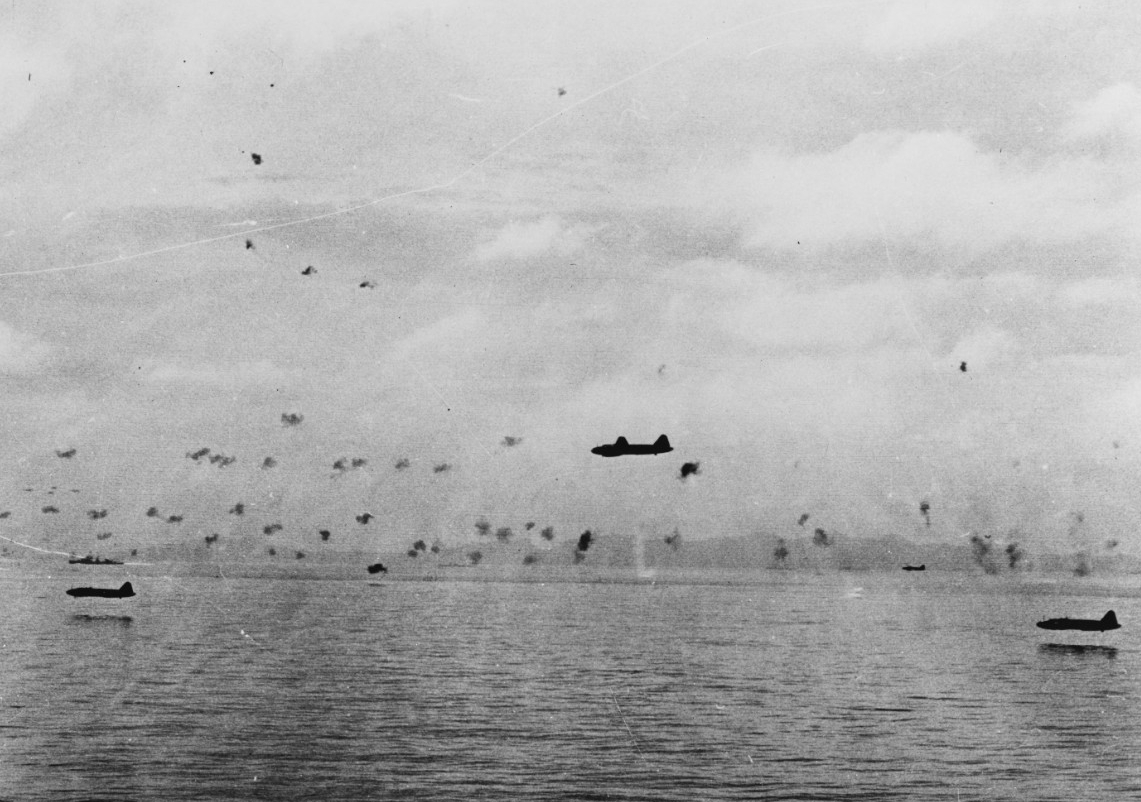
The Japanese reacted vigorously to the Allied landings, however, and Vice Adm. Mikawa Gunichi led a surface force that slipped undetected to the west of Savo Island and inflicted a singularly devastating defeat upon the Allies on the night of 8 and 9 August 1942. The Japanese ships slid between the Allied sentinels undetected and rounded the southern side of Savo Island, destroyer Yūnagi came about, possibly to guard the rear of the column, and at 0133 Mikawa gave the order “All Ships Attack!” A minute later Jarvis passed barely 3,000 yards northward of the Japanese ships, which seemingly mistook her for a New Zealand Achilles class light cruiser. Some of the enemy ships apparently trained their guns on Jarvis though held their fire, and heavy cruiser Furutaka fired torpedoes at Jarvis but the lethal weapons missed the ship.
Yūnagi steamed 295° at 26 knots at 0150 when she sighted Jarvis off her port side on roughly the opposite course at ten knots. Yūnagi rapidly overtook Jarvis on the U.S. destroyer’s starboard quarter and five minutes later opened fire. Chicago’s lookouts saw some of the gun flashes light the darkness as the Japanese shot at Jarvis, bearing 300° and at a distance of 14,000 yards from the cruiser. The Japanese noted the gaping hole torn by the torpedo in Jarvis and also claimed to hit her but broke off the action at about 0200, and, the destroyer, possibly further damaged, resumed her flight to freedom. Blue (DD-378) sighted Jarvis at 0325 and closed to within 500 yards but Jarvis seemingly misidentified Blue as a Japanese destroyer and increased speed, only to slow to eight knots. Watchstanders on board Blue noted the large oil slick that Jarvis trailed, which was quite pronounced even in the darkness. Blue reversed course and resumed her patrol, and Jarvis continued the voyage. Mikawa’s overwhelming victory proved illusory in the long term, however, because he failed to attack the nearby transports when he came about to clear the area by sunrise and escape aerial retaliation. The supply ships withdrew but the limited amount of cargo which they had landed, combined with those the marines seized from the Japanese, to enable the Leathernecks to maintain their tenuous hold on Guadalcanal.
Jarvis continued to retire westward but the gallant destroyer had little speed, few operative guns, and no radio communications. After daybreak, Saratoga launched eight Douglas SBD-3s to search for the elusive enemy astern of the carrier out to 175 miles, and one of the Dauntlesses sighted Jarvis, steering 225° at ten knots but still trailing fuel oil and down by the bow, near 09°42'S, 158°59'E. The scout plane’s sighting proved to be the last time that Americans saw Jarvis.
The Japanese dispatched four planes from Rabaul on New Britain to scour the seas for their foes, and one of the aircraft flew toward Mono Island and on its return patrol leg at 0935 sighted Jarvis, bearing 231° and about 100 miles from Tulagi. Another one of the planes discovered the destroyer as well at 1100, but the pilot misidentified her as an Achilles-class ship. The snooper determinedly tracked Jarvis while Lt. Nakamura Tomoo led a strike group of 17 Type 1s of the Misawa Kōkūtai, escorted by 15 Mitsubishi A6M2 Type 0 carrier fighters, against the U.S. carriers that diverted to assail the ship. Nakamura and his strike group reached the scene by about 1300, relieved the shadower, and attacked. The badly damaged destroyer proved no match for the bombers and they torpedoed her more than 130 miles southeast of Tulagi, not far from where the Dauntless had sighted her. Jarvis put up a stout fight and splashed two of the attacking planes, a third ditched due to battle damage, and the warship lightly damaged three more planes, but the enemy recorded that Jarvis “split and sank” at about 1300 on 9 August 1942, and she went down with all hands.
Navy Communiqué No. 131 of 24 September 1942 announced the sad news to the American people: “The USS JARVIS (destroyer), which was damaged as a result of enemy air attacks off Guadalcanal, must be presumed lost at sea enroute from Tulagi to a southern repair base. The JARVIS has been overdue for several weeks and intensive search by ships and aircraft has failed to locate her or reveal any trace of her personnel. It is assumed that she was sunk by enemy submarines or aircraft.” Jarvis was stricken from the Navy Register on 2 October 1942.
Jarvis received three battle stars for World War II service.
| Commanding Officers | Date Assumed Command |
| Lt. Cmdr. Robert R. Ferguson | 27 October 1937 |
| Lt. Cmdr. Thomas J. Casey | 24 December 1938 |
| Lt. Cmdr. Corydon H. Kimball | 16 June 1939 |
| Lt. Leonidas W. Pancoast | 14 June 1941 |
| Lt. Cmdr. James R. Topper | 16 August 1941 |
| Lt. Cmdr. William R. Thayer | 16 December 1941 |
| Lt. Cmdr. William W. Graham | 21 May 1942 |
Mark L. Evans
5 July 2017


